instrument panel MITSUBISHI SHOGUN 2008 Owner's Manual (in English)
[x] Cancel search | Manufacturer: MITSUBISHI, Model Year: 2008, Model line: SHOGUN, Model: MITSUBISHI SHOGUN 2008Pages: 538, PDF Size: 25.09 MB
Page 6 of 538
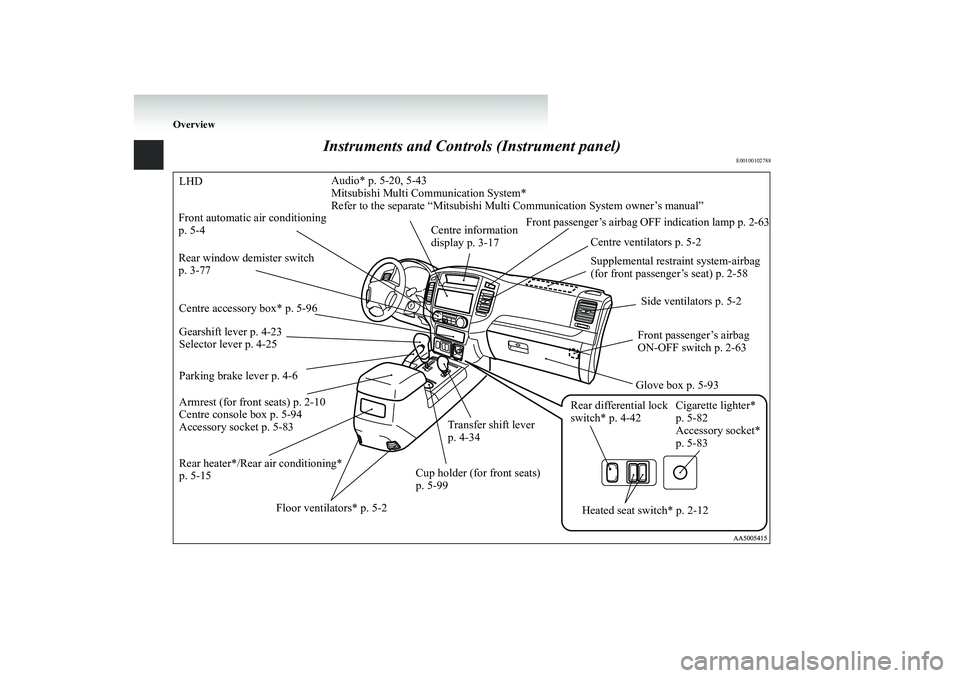
Overview
Instruments and Contro
ls (Instrument panel)
E00100102788
Supplemental restraint system-airbag (for front passenger’s seat) p. 2-58
Side ventilators p. 5-2
Rear window demister switch p. 3-77 Armrest (for front seats) p. 2-10 Centre console box p. 5-94Accessory socket p. 5-83 Front automatic air conditioning p. 5-4
Centre information display p. 3-17
Cigarette lighter* p. 5-82 Accessory socket* p. 5-83
Transfer shift lever p. 4-34
Rear heater*/Rear
air conditioning*
p. 5-15
Cup holder (for front seats) p. 5-99
Floor ventilators* p. 5-2
Audio* p. 5-20, 5-43 Mitsubishi Multi Communication System* Refer to the separate “Mitsubishi Multi Communication System owner’s manual”
Gearshift lever p. 4-23 Selector lever p. 4-25
Rear differential lock switch* p. 4-42
Centre ventilators p. 5-2
Parking brake lever p. 4-6
Heated seat switch* p. 2-12
LHD Centre accessory box* p. 5-96
Front passenger’s airbag OFF indication lamp p. 2-63
Front passenger’s airbag ON-OFF switch p. 2-63 Glove box p. 5-93
BK-BK2008E1ENUK.en-uk-Section2.fm Page 3 Wednesday, January 9, 2008 4:26 PM
Page 16 of 538
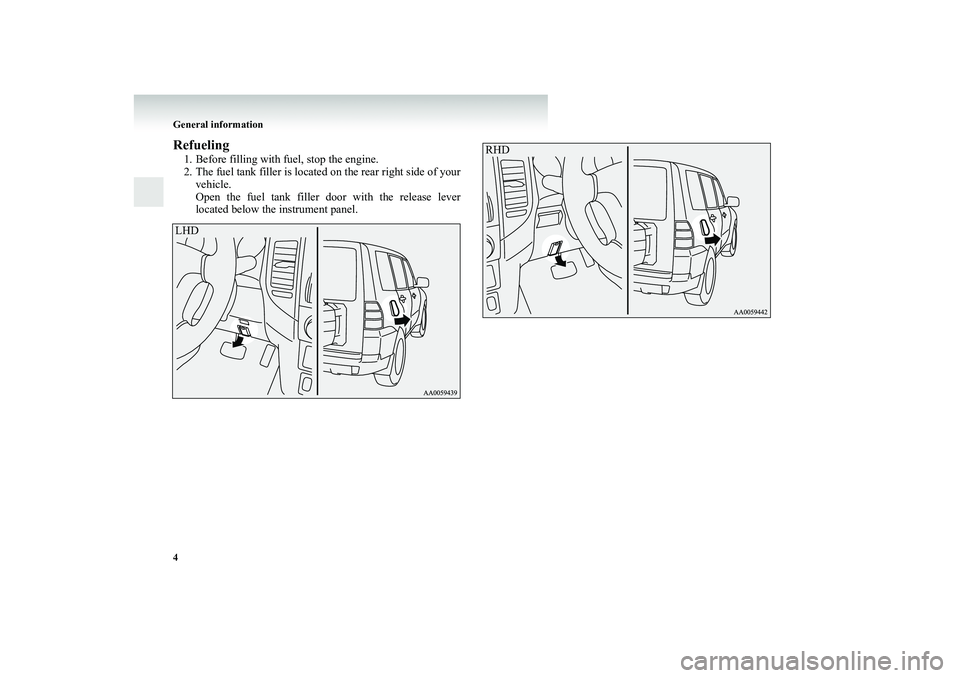
4 General informationRefueling1. Before filling with fuel, stop the engine. 2. The fuel tank filler is located on the rear right side of your
vehicle. Open the fuel tank filler
door with the release lever
located below the instrument panel.
LHD
RHD
BK-BK2008E1ENUK.en-uk-Section3.fm Page 4 Wednesday, January 9, 2008 4:21 PM
Page 84 of 538
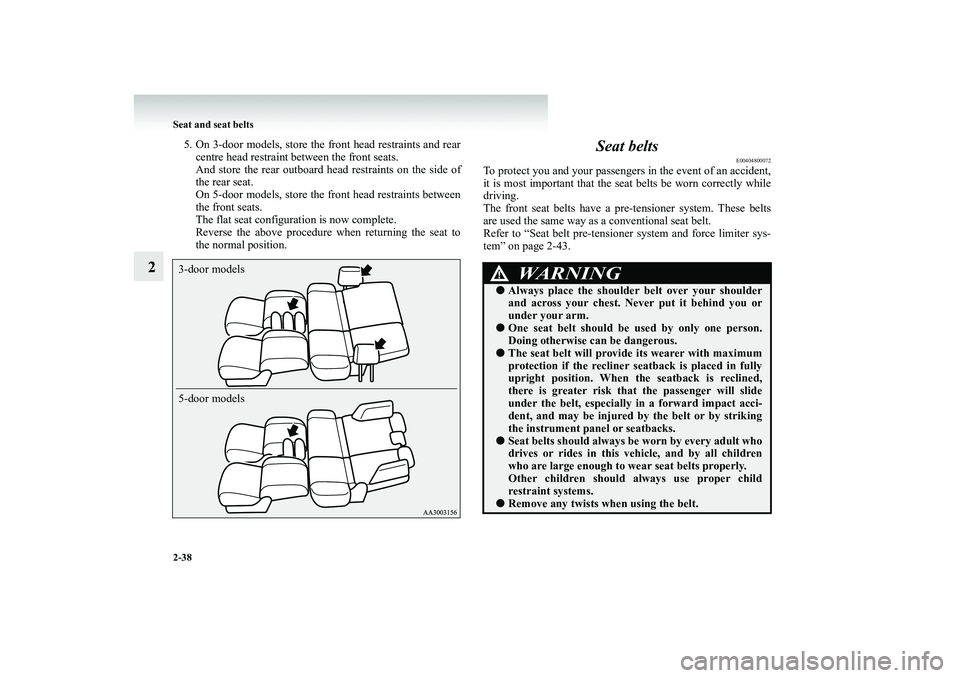
2-38 Seat and seat belts
2
5. On 3-door models, store the front head restraints and rear
centre head restraint between the front seats. And store the rear outboard head restraints on the side of the rear seat.On 5-door models, store the front head restraints between the front seats. The flat seat configur
ation is now complete.
Reverse the above procedure when returning the seat to the normal position.
Seat belts
E00404800072
To protect you and your passengers
in the event of an accident,
it is most important that the seat
belts be worn correctly while
driving.The front seat belts have a pr
e-tensioner system. These belts
are used the same way as a conventional seat belt. Refer to “Seat belt pre-tensione
r system and force limiter sys-
tem” on page 2-43.
3-door models 5-door models
WARNING
!●
Always place the should
er belt over your shoulder
and across your chest. Never put it behind you or under your arm.
●
One seat belt should be used by only one person. Doing otherwise can be dangerous.
●
The seat belt will provid
e its wearer with maximum
protection if the recliner seat
back is placed in fully
upright position. When th
e seatback is reclined,
there is greater risk that
the passenger will slide
under the belt, especially
in a forward impact acci-
dent, and may be injured by the belt or by striking the instrument panel or seatbacks.
●
Seat belts should always be
worn by every adult who
drives or rides in this ve
hicle, and by all children
who are large enough to wear seat belts properly. Other children should always use proper childrestraint systems.
●
Remove any twists when using the belt.
BK-BK2008E1ENUK.en-uk-Section5.fm Page
38 Wednesday, January 9, 2008 4:28 PM
Page 86 of 538
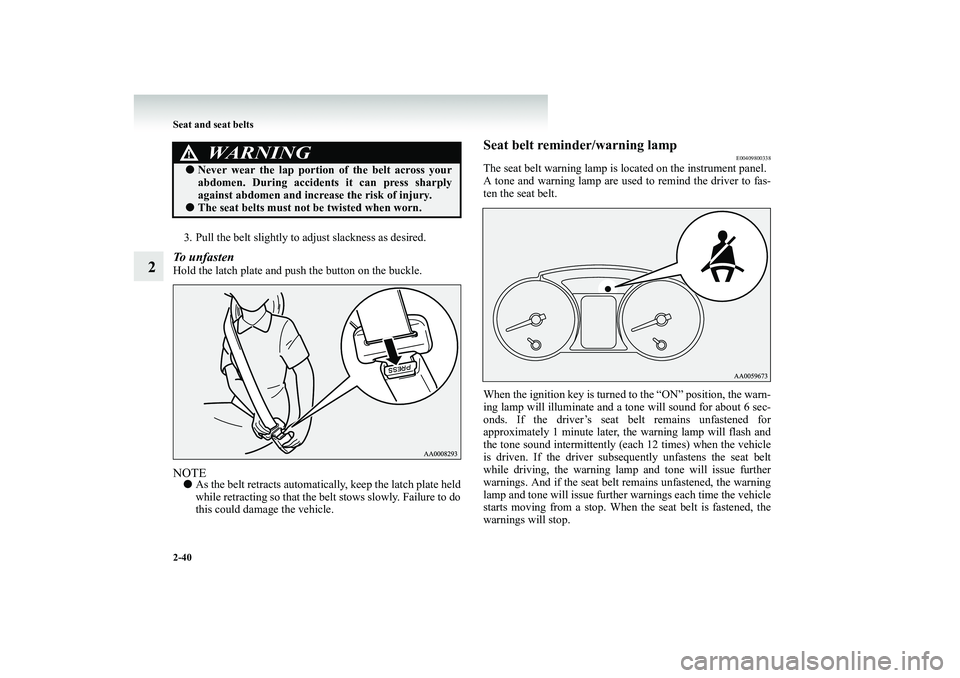
2-40 Seat and seat belts
2
3. Pull the belt slightly to adjust slackness as desired.To unfasten Hold the latch plate and pu
sh the button on the buckle.
NOTE●
As the belt retracts automatically, keep the latch plate held while retracting so that the belt stows slowly. Failure to dothis could damage the vehicle.
Seat belt reminder/warning lamp
E00409800338
The seat belt warning lamp is located on the instrument panel.A tone and warning lamp are used to remind the driver to fas- ten the seat belt. When the ignition key is turned to the “ON” position, the warn- ing lamp will illuminate and a tone will sound for about 6 sec- onds. If the driver’s seat belt remains unfastened for approximately 1 minute later, the warning lamp will flash andthe tone sound intermittently (each 12 times) when the vehicle is driven. If the driver subseq
uently unfastens the seat belt
while driving, the warning lamp and tone will issue furtherwarnings. And if the seat belt remains unfastened, the warning lamp and tone will issue further
warnings each time the vehicle
starts moving from a stop. When
the seat belt is fastened, the
warnings will stop.
WARNING
!●
Never wear the lap portio
n of the belt across your
abdomen. During accident
s it can press sharply
against abdomen and increa
se the risk of injury.
●
The seat belts must not be twisted when worn.
BK-BK2008E1ENUK.en-uk-Section5.fm Page
40 Wednesday, January 9, 2008 4:28 PM
Page 106 of 538
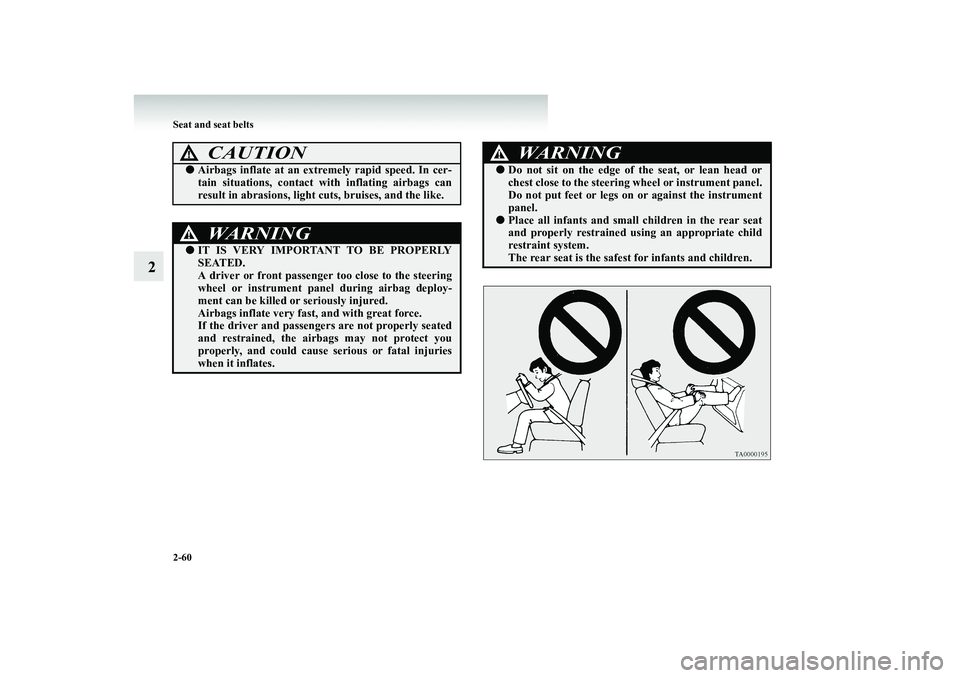
2-60 Seat and seat belts
2
CAUTION
!●
Airbags inflate at an extremely rapid speed. In cer- tain situations, contact wi
th inflating airbags can
result in abrasions, light cuts, bruises, and the like.WARNING
!●
IT IS VERY IMPORTANT TO BE PROPERLY SEATED. A driver or front passenger too close to the steeringwheel or instrument panel during airbag deploy- ment can be killed or seriously injured. Airbags inflate very fast
, and with great force.
If the driver and passengers are not properly seated and restrained, the airbags may not protect you properly, and could cause
serious or fatal injuries
when it inflates.
WARNING
!●
Do not sit on the edge of the seat, or lean head or chest close to the steering wheel or instrument panel.Do not put feet or legs on
or against the instrument
panel.
●
Place all infants and small
children in the rear seat
and properly restrained using an appropriate child restraint system. The rear seat is the safest
for infants and children.
BK-BK2008E1ENUK.en-uk-Section5.fm Page
60 Wednesday, January 9, 2008 4:28 PM
Page 107 of 538
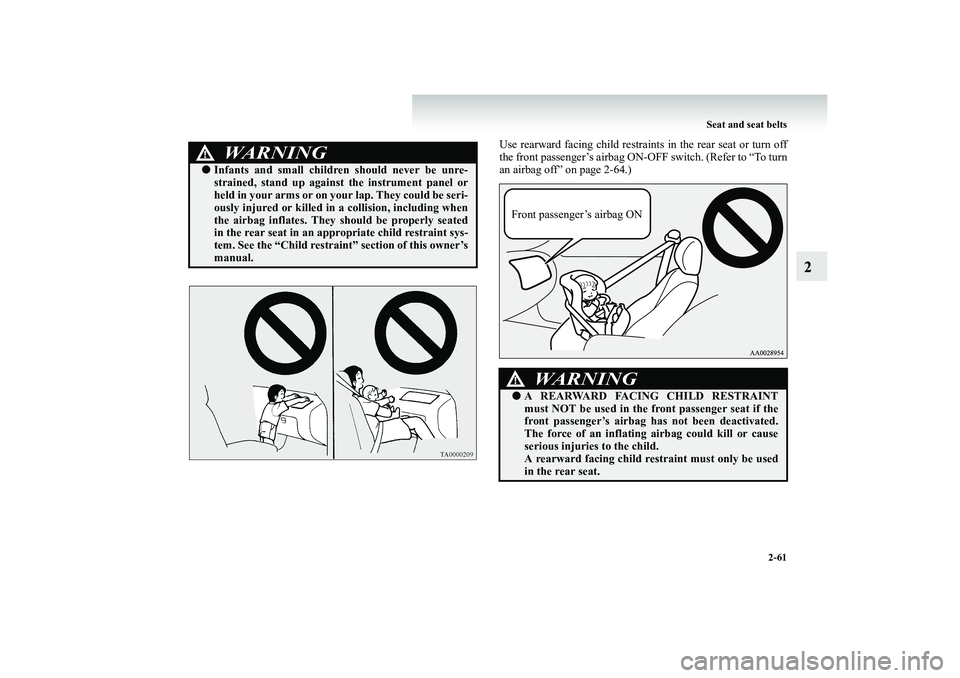
Seat and seat belts
2-61
2
Use rearward facing child restraints
in the rear seat or turn off
the front passenger’s airbag ON
-OFF switch. (Refer to “To turn
an airbag off” on page 2-64.)
WARNING
!●
Infants and small children
should never be unre-
strained, stand up agains
t the instrument panel or
held in your arms or on you
r lap. They could be seri-
ously injured or killed in a collision, including when the airbag inflates. They
should be properly seated
in the rear seat in an a
ppropriate child
restraint sys-
tem. See the “Child restrain
t” section of this owner’s
manual.
WARNING
!●
A REARWARD FACING CHILD RESTRAINT must NOT be used in the front passenger seat if thefront passenger’s airbag
has not been deactivated.
The force of an inflating airbag could kill or cause serious injuries to the child.A rearward facing child re
straint must only be used
in the rear seat.
Front passenger’s airbag ON
BK-BK2008E1ENUK.en-uk-Section5.fm Page
61 Wednesday, January 9, 2008 4:28 PM
Page 109 of 538
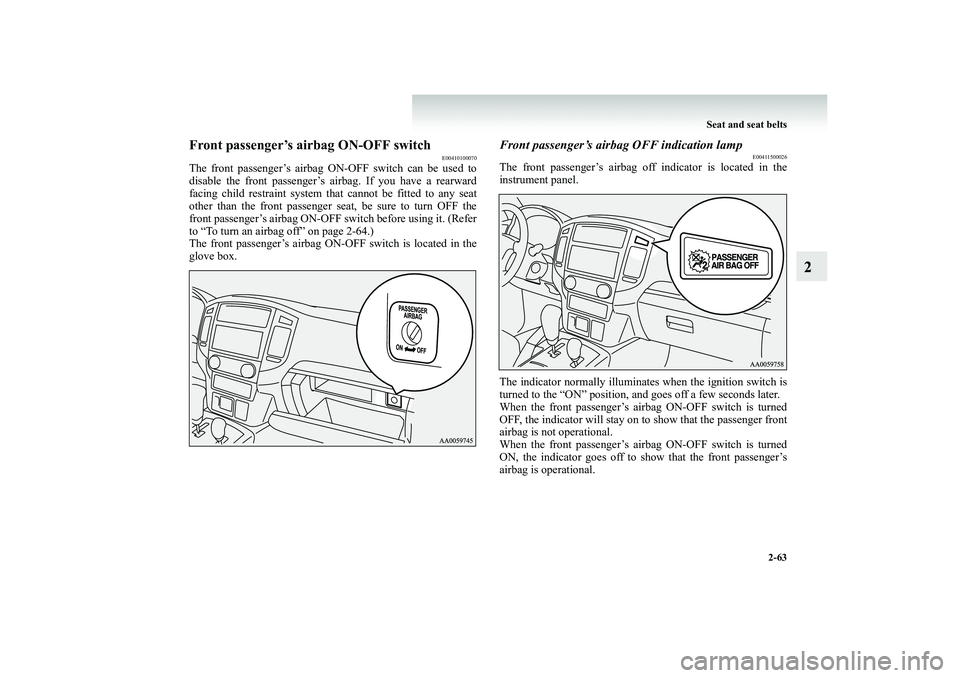
Seat and seat belts
2-63
2
Front passenger’s airbag ON-OFF switch
E00410100070
The front passenger’s airbag
ON-OFF switch can be used to
disable the front passenger’s ai
rbag. If you have a rearward
facing child restraint system that cannot be fitted to any seat other than the front passenger seat, be sure to turn OFF thefront passenger’s airbag ON-OFF switch before using it. (Refer to “To turn an airbag off” on page 2-64.) The front passenger’s airbag ON-OFF switch is located in theglove box.
Front passenger’s airbag OFF indication lamp
E00411500026
The front passenger’s airbag of
f indicator is located in the
instrument panel. The indicator normally illuminates when the ignition switch is turned to the “ON” position, and goes off a few seconds later.When the front passenger’s airb
ag ON-OFF switch is turned
OFF, the indicator will stay on to show that the passenger front airbag is not operational.When the front passenger’s airb
ag ON-OFF switch is turned
ON, the indicator goes off to show that the front passenger’s airbag is operational.
BK-BK2008E1ENUK.en-uk-Section5.fm Page
63 Wednesday, January 9, 2008 4:28 PM
Page 111 of 538
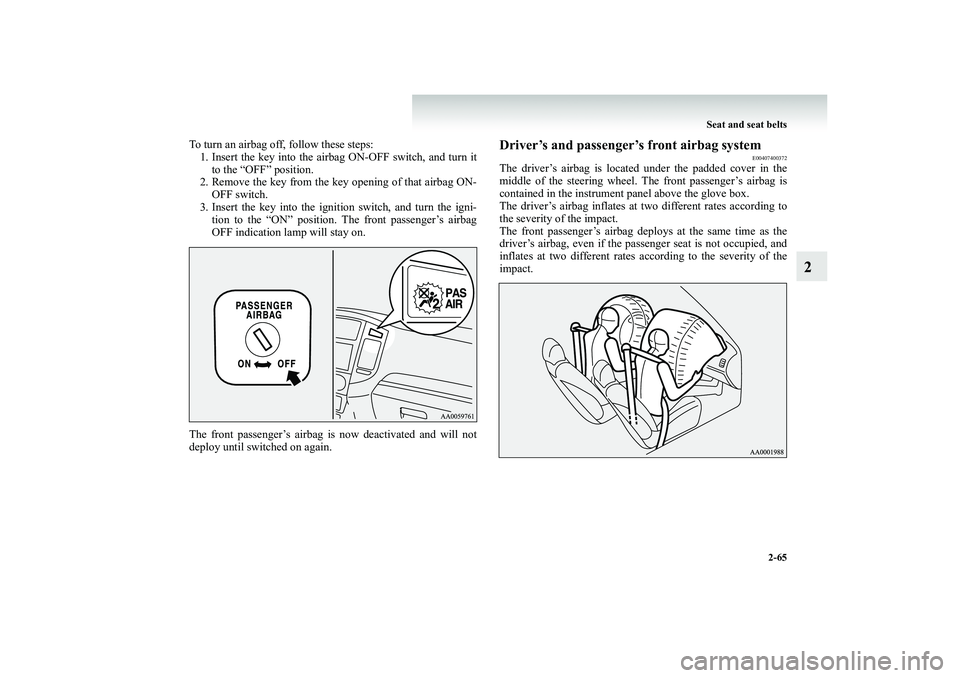
Seat and seat belts
2-65
2
To turn an airbag off, follow these steps: 1. Insert the key into the airbag ON-OFF switch, and turn it
to the “OFF” position.
2. Remove the key from the key opening of that airbag ON-
OFF switch.
3. Insert the key into the ignition switch, and turn the igni-
tion to the “ON” position. The front passenger’s airbagOFF indication lamp will stay on.
The front passenger’s airbag is
now deactivated and will not
deploy until switched on again.
Driver’s and passenger’s front airbag system
E00407400372
The driver’s airbag is located
under the padded cover in the
middle of the steering wheel. Th
e front passenger’s airbag is
contained in the instrument panel above the glove box. The driver’s airbag inflates at
two different rates according to
the severity of the impact. The front passenger’s airbag de
ploys at the same time as the
driver’s airbag, even if the passe
nger seat is not occupied, and
inflates at two different rates
according to the severity of the
impact.
BK-BK2008E1ENUK.en-uk-Section5.fm Page
65 Wednesday, January 9, 2008 4:28 PM
Page 112 of 538
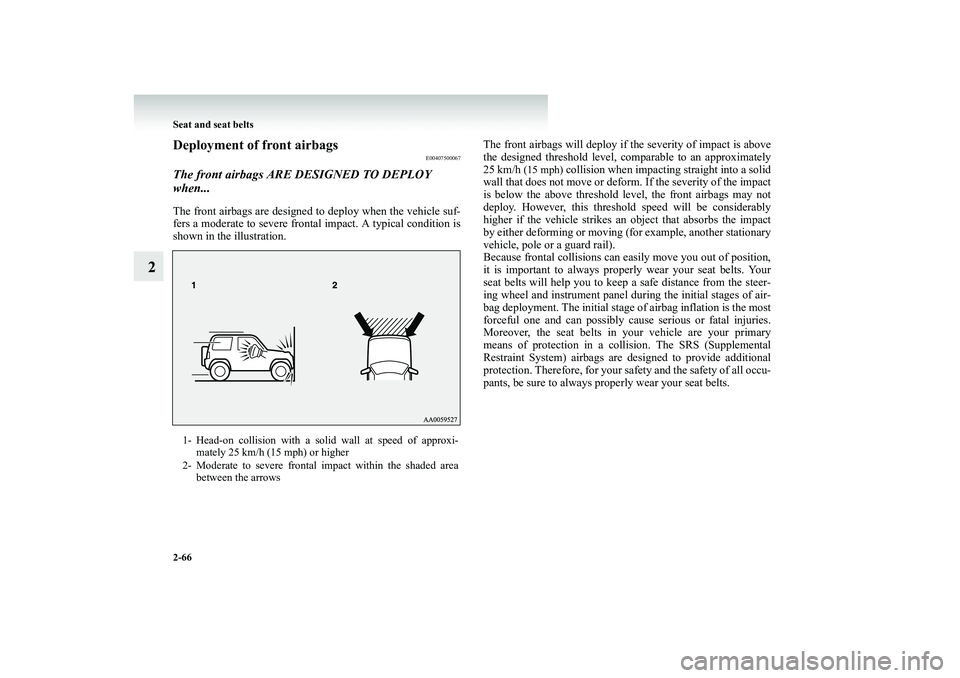
2-66 Seat and seat belts
2
Deployment of front airbags
E00407500067
The front airbags ARE DESIGNED TO DEPLOY when...The front airbags are designed
to deploy when the vehicle suf-
fers a moderate to severe frontal impact. A typical condition is shown in the illustration.
The front airbags will deploy if the severity of impact is above the designed threshold level, co
mparable to an approximately
25 km/h
(15 mph)
collision when impacting straight into a solid
wall that does not move or deform. If the severity of the impactis below the above threshold level, the front airbags may not deploy. However, this threshold speed will be considerably higher if the vehicle strikes an
object that absorbs the impact
by either deforming or moving (for example, another stationary vehicle, pole or a guard rail). Because frontal collisions can
easily move you out of position,
it is important to always properl
y wear your seat belts. Your
seat belts will help you to keep
a safe distance from the steer-
ing wheel and instrument panel during the initial stages of air-bag deployment. The initial stage of airbag inflation is the most forceful one and can possibly ca
use serious or fatal injuries.
Moreover, the seat belts in
your vehicle are your primary
means of protection in a col
lision. The SRS (Supplemental
Restraint System) airbags are de
signed to provide additional
protection. Therefore, for your sa
fety and the safety of all occu-
pants, be sure to always properly wear your seat belts.
1- Head-on collision with a solid wall at speed of approxi-
mately 25 km/h (15 mph) or higher
2- Moderate to severe frontal impact within the shaded area
between the arrows
BK-BK2008E1ENUK.en-uk-Section5.fm Page
66 Wednesday, January 9, 2008 4:28 PM
Page 114 of 538
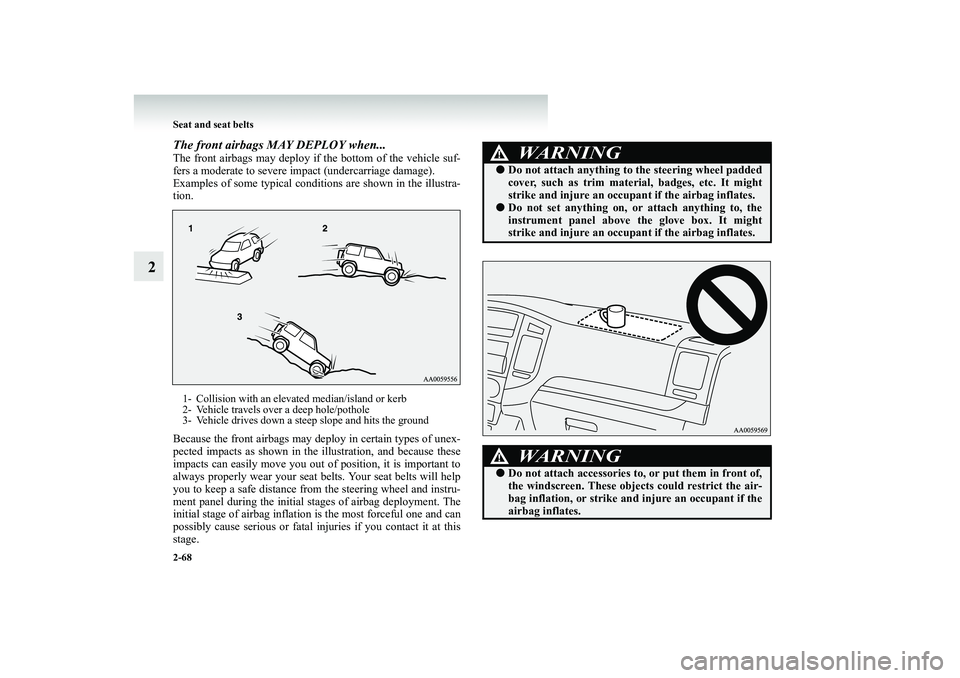
2-68 Seat and seat belts
2
The front airbags MAY DEPLOY when...The front airbags may deploy if the bottom of the vehicle suf- fers a moderate to severe impact (undercarriage damage). Examples of some typical cond
itions are shown in the illustra-
tion. Because the front airbags may de
ploy in certain types of unex-
pected impacts as shown in the
illustration, an
d because these
impacts can easily move you out of position, it is important to always properly wear your seat
belts. Your seat belts will help
you to keep a safe distance from
the steering wh
eel and instru-
ment panel during the initial stages of airbag deployment. The initial stage of airbag inflation
is the most for
ceful one and can
possibly cause serious or fatal injuries if you contact it at this stage.1- Collision with an elevated median/island or kerb 2- Vehicle travels over a deep hole/pothole 3- Vehicle drives down a steep slope and hits the ground
WARNING
!●
Do not attach anything to
the steering wheel padded
cover, such as trim materi
al, badges, etc. It might
strike and injure an occupa
nt if the airbag inflates.
●
Do not set anything on, or attach anything to, the instrument panel above the glove box. It mightstrike and injure an occupa
nt if the airbag inflates.
WARNING
!●
Do not attach accessories to, or put them in front of, the windscreen. These object
s could restrict the air-
bag inflation, or strike and
injure an occupant if the
airbag inflates.
BK-BK2008E1ENUK.en-uk-Section5.fm Page
68 Wednesday, January 9, 2008 4:28 PM